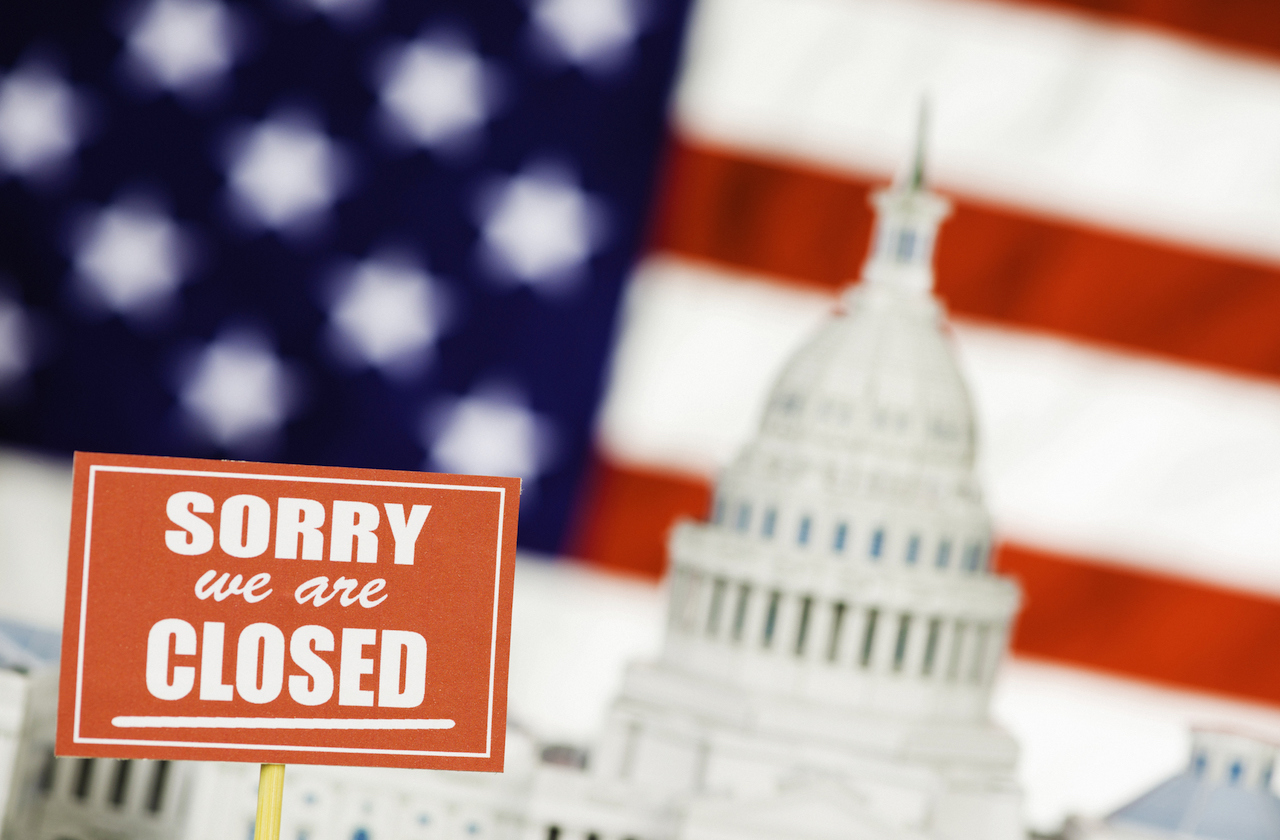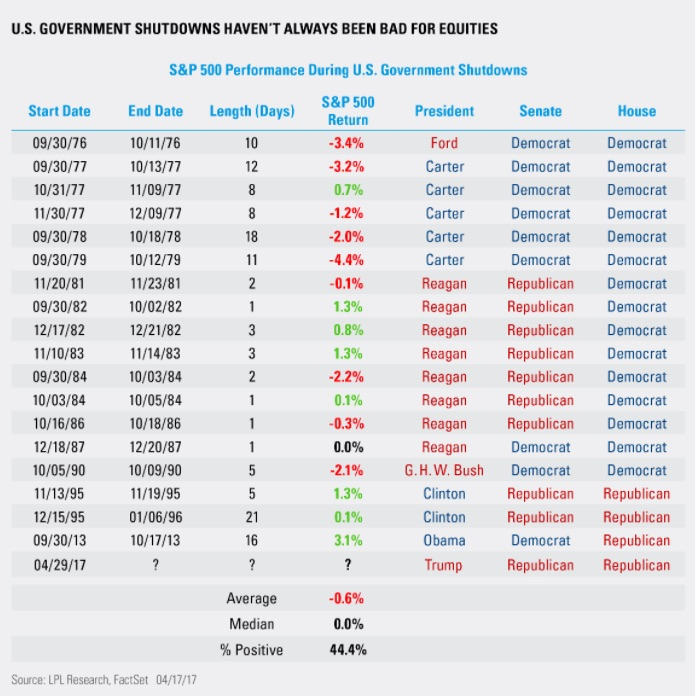Will a Government Shutdown Trigger a Market Meltdown?
The clock is ticking on a potential government shutdown, leaving investors to wonder what could happen to this bull run in stocks.


Congress is working on its fourth stopgap spending bill since the 2018 fiscal year started in October 2017. If it can’t pass a bill by the end of Friday, Jan. 18, America could suffer a partial government shutdown – and even if the Legislature does get the job done, it will merely kick the can down the road to next month, where another impasse may loom.
But whether it’s Friday, or in February, or whenever – if the government shuts down, that does not mean the bull market will too.
It’s understandable if investors are getting nervous. They’re celebrating the market’s record sprint to Dow 26,000, and now the folks in Washington, D.C., look like they might just dump something in the punch bowl.

Sign up for Kiplinger’s Free E-Newsletters
Profit and prosper with the best of expert advice on investing, taxes, retirement, personal finance and more - straight to your e-mail.
Profit and prosper with the best of expert advice - straight to your e-mail.
A government shutdown is serious business. It creates chaos and hurts the economy. Even if lawmakers come up with another last-minute, stopgap funding bill, that just creates more uncertainty down the road. And as you may have heard, the market hates uncertainty.
With the clock ticking down, investors are rightly wondering what they should do in the event of a government shutdown. We’re here to help. Here’s how to handle the situation in three easy steps:
Don’t Panic
Stocks are at all-time highs. By some measures, they're more expensive than they have been in nearly a decade, with the Standard & Poor’s 500-stock index going for more than 26 times trailing 12-month earnings. Moreover, the current bull market is the second-longest in history, just months away from reaching the nine-year mark.
It’s natural, then, to worry about headlines that could put an end to the rally.
However, neither worrying about government shutdowns nor the actual shutdowns themselves are novel experiences for equity investors, experts note. And it always has worked out OK in the past.
“The market has seen this before, and while the short-term reaction is unpredictable, it tends to be short-lived,” says Oliver Pursche, chief market strategist at Bruderman Asset Management.
Indeed, there have been 18 government shutdowns since 1976, according to LPL Financial and FactSet. They have ranged in length from one to 21 days, and have produced an average loss for the S&P 500 of – wait for it – 0.6%. Even the worst loss, from September to October 1979, was a mere 4.4% that the market clawed back by the start of 1980.
Historically speaking, the market doesn’t seem to care about whether Washington shows up for work.
Buy Dips
Investors still should be at least prepared for a potential hiccup in the markets – that’s just prudent planning. After all, a short government shutdown would affect some small level of spending, which could put an unexpected blemish on what’s otherwise expected to be a rosy 2018 for corporate America.
But rather than being ready to head for the hills, investors should put together a shopping list.
A massive corporate tax cut promises to boost profits for many American companies. And a repatriation tax holiday on overseas cash has numerous corporations bringing home billions of dollars, much of which is being pledged toward new jobs, wage hikes and other investments that should fuel domestic growth. That all points to continued gains for stocks – which is why a government shutdown-sparked drop in the market should be viewed as a dip-buying opportunity.
After all, the idea is to buy low, and when estimated earnings-growth rates are taken into account, stock prices don’t look so out of whack. The S&P 500 trades for a bit more than 18 times analysts’ expectations for future earnings, according to data from Thomson Reuters. That’s not much higher than its long-term average of 17.6, according to FactSet.
Any pullback in share prices, then, will afford investors an opportunity to buy stocks at valuations closer to historical norms.
Enjoy the Ride?
If anything, the market seems to have almost developed an appreciation of government shutdowns. The S&P 500 has actually delivered gains the past three times Congress couldn’t agree on a spending bill.
When the government was closed for 16 days in 2013, the S&P 500 rose a whopping 3.1%. (See the accompanying table, courtesy of LPL Financial and FactSet.) A 21-day shutdown from December 1995 to January 1996 resulted in a 0.1% increase in the benchmark index. And a five-day shutdown in November 1995 delivered a gain of 1.3%.

With numbers like that, investors should be praying for as many shutdowns as they can get.
That is said in jest, of course. But this does hammer home the point that Wall Street does not view government shutdowns as top-priority bear triggers. Why? Because they ultimately have little effect on what actually moves share prices.
“Markets rise and fall based on economic conditions and corporate earnings,” Pursche says. “And right now, it looks like both are going to continue to rise, which should bode well for the market. In short, ignore the news headlines and focus on what matters – data, and the data looks good.”
Get Kiplinger Today newsletter — free
Profit and prosper with the best of Kiplinger's advice on investing, taxes, retirement, personal finance and much more. Delivered daily. Enter your email in the box and click Sign Me Up.

Dan Burrows is Kiplinger's senior investing writer, having joined the august publication full time in 2016.
A long-time financial journalist, Dan is a veteran of MarketWatch, CBS MoneyWatch, SmartMoney, InvestorPlace, DailyFinance and other tier 1 national publications. He has written for The Wall Street Journal, Bloomberg and Consumer Reports and his stories have appeared in the New York Daily News, the San Jose Mercury News and Investor's Business Daily, among many other outlets. As a senior writer at AOL's DailyFinance, Dan reported market news from the floor of the New York Stock Exchange.
Once upon a time – before his days as a financial reporter and assistant financial editor at legendary fashion trade paper Women's Wear Daily – Dan worked for Spy magazine, scribbled away at Time Inc. and contributed to Maxim magazine back when lad mags were a thing. He's also written for Esquire magazine's Dubious Achievements Awards.
In his current role at Kiplinger, Dan writes about markets and macroeconomics.
Dan holds a bachelor's degree from Oberlin College and a master's degree from Columbia University.
Disclosure: Dan does not trade individual stocks or securities. He is eternally long the U.S equity market, primarily through tax-advantaged accounts.
-
 Financial Planning's Paradox: Balancing Riches and True Wealth
Financial Planning's Paradox: Balancing Riches and True WealthWhile enough money is important for financial security, it does not guarantee fulfillment. How can retirees and financial advisers keep their eye on the ball?
By Richard P. Himmer, PhD Published
-
 A Confident Retirement Starts With These Four Strategies
A Confident Retirement Starts With These Four StrategiesWork your way around income gaps, tax gaffes and Social Security insecurity with some thoughtful planning and analysis.
By Nick Bare, CFP® Published
-
 Why Is Warren Buffett Selling So Much Stock?
Why Is Warren Buffett Selling So Much Stock?Berkshire Hathaway is dumping equities, hoarding cash and making market participants nervous.
By Dan Burrows Published
-
 If You'd Put $1,000 Into Google Stock 20 Years Ago, Here's What You'd Have Today
If You'd Put $1,000 Into Google Stock 20 Years Ago, Here's What You'd Have TodayGoogle parent Alphabet has been a market-beating machine for ages.
By Dan Burrows Last updated
-
 Stock Market Today: Stocks Retreat Ahead of Nvidia Earnings
Stock Market Today: Stocks Retreat Ahead of Nvidia EarningsMarkets lost ground on light volume Wednesday as traders keyed on AI bellwether Nvidia earnings after the close.
By Dan Burrows Published
-
 Stock Market Today: Stocks Edge Higher With Nvidia Earnings in Focus
Stock Market Today: Stocks Edge Higher With Nvidia Earnings in FocusNvidia stock gained ground ahead of tomorrow's after-the-close earnings event, while Super Micro Computer got hit by a short seller report.
By Karee Venema Published
-
 Stock Market Today: Dow Hits New Record Closing High
Stock Market Today: Dow Hits New Record Closing HighThe Nasdaq Composite and S&P 500 finished in the red as semiconductor stocks struggled.
By Karee Venema Published
-
 Stock Market Today: Stocks Pop After Powell's Jackson Hole Speech
Stock Market Today: Stocks Pop After Powell's Jackson Hole SpeechFed Chair Powell's Jackson Hole speech struck a dovish tone which sent stocks soaring Friday.
By Karee Venema Published
-
 Stock Market Today: Stocks Drop Ahead of Powell's Jackson Hole Speech
Stock Market Today: Stocks Drop Ahead of Powell's Jackson Hole SpeechSentiment turned cautious ahead of Fed Chair Powell's highly anticipated speech Friday at the Jackson Hole Economic Symposium.
By Karee Venema Published
-
 Stock Market Today: Stocks Rise After Jobs Data Lifts Rate-Cut Odds
Stock Market Today: Stocks Rise After Jobs Data Lifts Rate-Cut OddsPreliminary data from the Bureau of Labor Statistics shows job growth was lower than previously estimated.
By Karee Venema Published